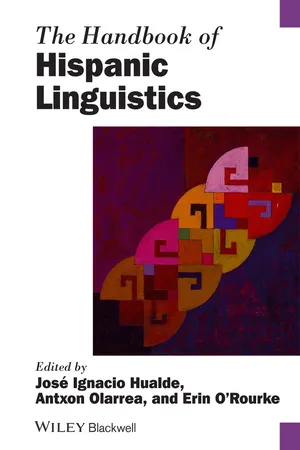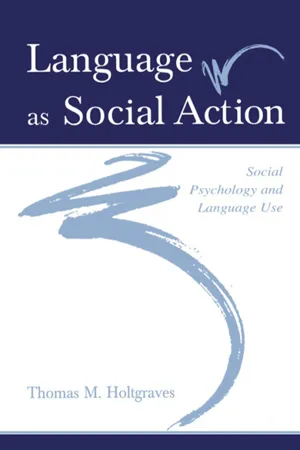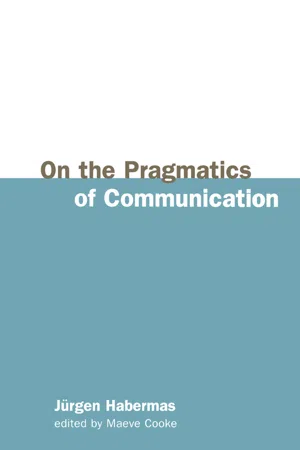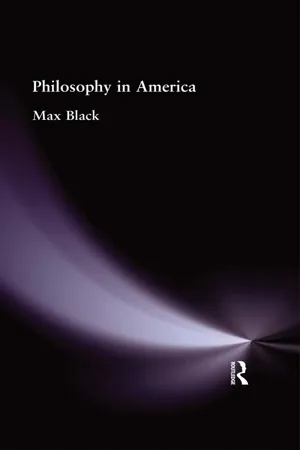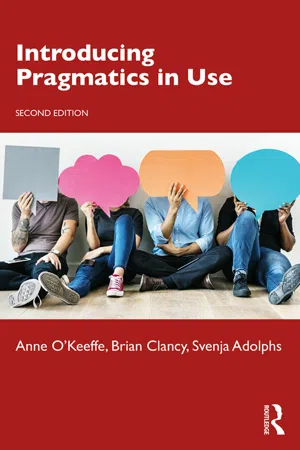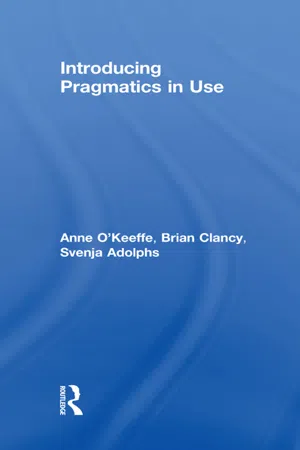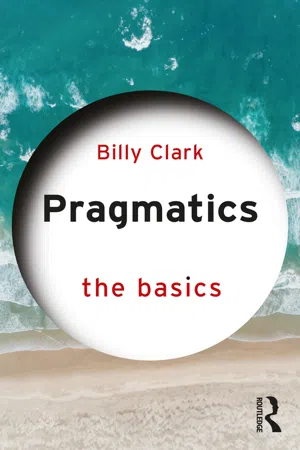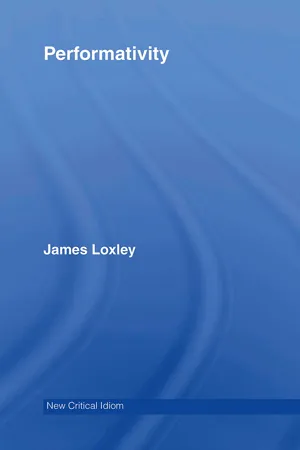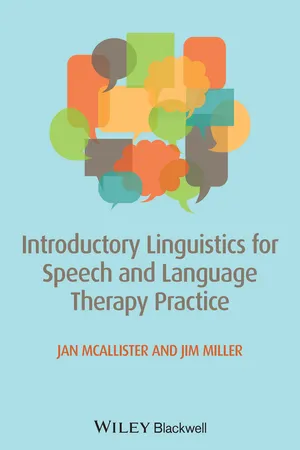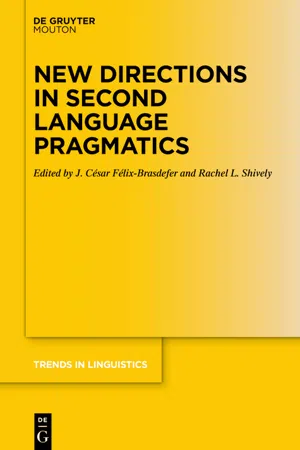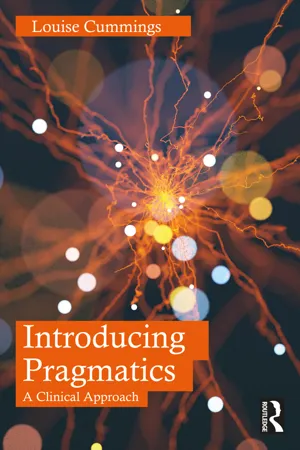Languages & Linguistics
Speech Acts
Speech acts refer to the actions performed through speech, such as making requests, giving orders, or making promises. This concept, introduced by philosopher J.L. Austin and further developed by John Searle, emphasizes that utterances not only convey information but also have the power to perform actions. Speech acts are an important aspect of pragmatics, the study of language use in context.
Written by Perlego with AI-assistance
Related key terms
1 of 4
Related key terms
1 of 3
12 Key excerpts on "Speech Acts"
- eBook - ePub
- John Flowerdew(Author)
- 2012(Publication Date)
- Routledge(Publisher)
CHAPTER 5Speech Acts
5.1 Speech Acts AND PRAGMATICS
Pragmatics is to do with how language is used in context and the relationship between language use and language form. It deals with various aspects of non-literal meaning, aspects of meaning which are not taken into account by the code/conduit model of communication referred to in Chapter 1 . These aspects of non-literal meaning are dealt with under designations such as: Speech Acts; conversational implicature; the Cooperative Principle, politeness and relevance. In this chapter we will focus on Speech Acts; we will deal with the other topics in the next chapter.5.2 DEFINITION OF Speech Acts
An early discourse analyst, Labov (1972: 121), stated that ‘[t]he first and most important step in the formalisation of Discourse Analysis is to distinguish what is said from what is done’. Discourse Analysis should thus fundamentally be concerned with the functional rather than the formal features of language. The term ‘functional’ is suggestive of ‘language functions’, as in ‘functions’ and ‘notions’ in language teaching, if you are already familiar with the field. Indeed, this is what we will be talking about here, although we will use the more usual term in Linguistics and Pragmatics of ‘Speech Acts’. With Speech Acts, then, we are concerned with the functional, or communicative, value of utterances, with language used to perform actions — actions such as greeting, inviting, offering, ordering, promising, requesting, warning, and so forth.5.3 FORM AND FUNCTION
Sentences can be accounted for in terms of form or function. Consider the following three sentences: I need help. Can you help me? Help me!In terms of grammatical form, these sentences would be labelled declarative, interrogative and imperative, respectively. However, given the right circumstances, they might share the same function of seeking help. So form and function are different. The same function may be performed by a variety of forms. Conversely, the same form may express (given the right situation) a variety of functions. Consider the utterance ‘Can you help me?’, which is an interrogative. In some circumstances, this might be interpreted as a request for help. In other circumstances, it might be a question about my ability to help the speaker. Traditionally, the three grammatical forms of declarative, interrogative and imperative are presented in language teaching materials as equivalent to, respectively, statements, questions and commands. The above examples demonstrate that this is somewhat misleading. Consider some possible ways of requesting a light for a cigarette. - eBook - ePub
- José Ignacio Hualde, Antxon Olarrea, Erin O'Rourke, José Ignacio Hualde, Antxon Olarrea, Erin O'Rourke(Authors)
- 2012(Publication Date)
- Wiley-Blackwell(Publisher)
29
Speech Acts
VICTORIA ESCANDELL-VIDAL1 Introduction
The idea that using language is a form of action has revealed a major source of inspiration for modern thinking. Linguistic utterances are not merely a way to truly describe states of affairs, but can be used to perform various activities, such as request, apologize and promise, among many others:(1) ¿Me prestas un boli? ‘Can I borrow a pen?’ (2) No sabes cuánto lo siento. ‘I am really sorry.’ (3) Allí estare. ‘I’ll be there.’Similarly, there are actions, such as betting, declaring and condemning, which cannot be carried out unless certain words are uttered:(4) a. Te apuesto 10 €. ‘I bet 10 €.’ b. Declaro inaugurado este congreso. ‘I hereby declare this conference open.’Some utterances have the power to count as actions:(5) a. Te prometo que estaré allí. ‘I promise to be there.’ b. Te invito a cenar. ‘I invite you for dinner.’The examples in (5) do not describe a fact, but rather perform an action: just by saying I promise , I am actually making a promise. These are performative utterances. In all these cases, language is a means for creating new states of affairs and introducing changes in the world, including not only the activities and the internal states of the participants, but also the relations among them. Utterances are, thus, Speech Acts , that is, intentional actions brought about through the interplay of the language faculty with other cognitive systems and the social and situational environment.To account for them, a multidisciplinary perspective is required that can encompass insights from different areas, including philosophy of language, grammar, human cognition, and social interaction: this is the realm of Pragmatics, a discipline developed over the last 50 years. Of course, the relationship between language and action had not gone unnoticed in earlier works, but only in the last decades have researchers gained full awareness of the difference between what an expression means – the field of Semantics-, and what it can be used for – the concern of Pragmatics. This has resulted in the conscious adoption of theoretical frameworks making specific claims about how to relate, and distinguish between, the contribution of linguistic items and that of contextual and situational factors. In this respect, current Spanish linguistics has followed the mainstream Anglo-American tradition, with the adaptation of the ideas in Austin (1962), Searle (1969), Grice (1975), Sperber and Wilson (1986) and Brown and Levinson (1987) (see Escandell-Vidal 1996a for an overview). Though original and innovative theoretical proposals are rather scarce – Sánchez de Zavala (1997) is possibly the most salient exception – significant contributions have been made in the form of very detailed accounts of the major kinds of Speech Acts and their conditions of adequacy. - eBook - ePub
Language As Social Action
Social Psychology and Language Use
- Thomas M. Holtgraves(Author)
- 2013(Publication Date)
- Psychology Press(Publisher)
1
Speech Acts and Intentions: The Things We Do with Words
People do things with their words. They order and promise and criticize and apologize and so on. In other words, to use language is to perform an action. As obvious as this is, an action view of language has had a relatively short history, and many of the implications of viewing language use as action have yet to be pursued in any detail. Moreover, viewing language as action, especially as a social action, makes clear many of the social psychological underpinnings of language use.There is a strain of thought in philosophy, developed primarily at Oxford University beginning in the 1930s, that is concerned with the analysis of the ordinary use of language. Two related lines of research within this tradition are of particular importance, and I will use them as the starting points for this chapter. The first, termed speech act theory, was developed by John Austin and later elaborated on by John Searle. Speech act theory explicitly conceptualizes linguistic meaning as use; what we mean with an utterance is the use to which the utterance is put. In the first half of the chapter I describe this approach and the issues that it raises for understanding language use. The second strand of thought revolves around the concept of conversational implicature, an approach to nonliteral meaning that was developed by Paul Grice. Grice’s views have been extremely influential and a central concern within the field of pragmatics. In the second half of this chapter I examine his ideas, placing particular emphasis on the recognition of speaker intention in general and illocutionary force in particular. Much of this discussion will be centered on the compre- hension of indirect Speech Acts and the various processing models that have been proposed and tested. - eBook - ePub
- Jürgen Habermas(Author)
- 2014(Publication Date)
- Polity(Publisher)
If I understand the command that my girlfriend gives me (or someone else) when she tells me (or that other person) to drop my gun, then I know fairly well what action she has carried out: she has uttered this specific command. This action does not remain in need of interpretation in the same sense as does the running past of my hurrying friend. For in the standard case of literal meaning, a speech act makes the intention of the speaker known; a hearer can infer from the semantic content of the utterance how the sentence uttered is being used, that is, what type of action is being performed with it. Speech Acts interpret themselves; they have a self-referential structure. The illocutionary element establishes, as a kind of pragmatic commentary, the sense in which what is said is being used. Austin’s insight that one does something by saying something has a reverse side to it: by performing a speech act, one also says what one is doing. Admittedly, this performative sense of a speech act reveals itself only to a potential hearer who, in adopting the stance of a second person, has given up the perspective of an observer in favor of that of a participant. One has to speak the same language and, as it were, enter the intersubjectively shared lifeworld of a linguistic community in order to benefit from the peculiar reflexivity of natural language and to be able to base the description of an action carried out with words on understanding the implicit self-commentary of this speech act.Speech Acts differ from simple nonlinguistic activities not only by virtue of this reflexive characteristic of self-interpretation but also by virtue of the kind of goals that can be intended through speaking, as well as the kind of successes that can be achieved. Certainly, at a general level, all actions, linguistic and nonlinguistic ones, can be conceived of as goal-oriented activity. However, as soon as we wish to differentiate between action oriented toward reaching understanding and purposive activity, - eBook - ePub
- Max Black(Author)
- 2014(Publication Date)
- Routledge(Publisher)
Austin claimed that there were over a thousand such expressions in English. By way of introduction, perhaps I can say why I think it is of interest and importance in the philosophy of language to study Speech Acts, or, as they are sometimes called, language acts or linguistic acts. I think it is essential to any specimen of linguistic communication that it involve a linguistic act. It is not, as has generally been supposed, the symbol or word or sentence, or even the token of the symbol or word or sentence, which is the unit of linguistic communication, but rather it is the production of the token in the performance of the speech act that constitutes the basic unit of linguistic communication. To put this point more precisely, the production of the sentence token under certain conditions is the illocutionary act, and the illocutionary act is the minimal unit of linguistic communication. I do not know how to prove that linguistic communication essentially involves acts but I can think of arguments with which one might attempt to convince someone who was sceptical. One argument would be to call the sceptic’s attention to the fact that when he takes a noise or a mark on paper to be an instance of linguistic communication, as a message, one of the things that is involved in his so taking that noise or mark is that he should regard it as having been produced by a being with certain intentions. He cannot just regard it as a natural phenomenon, like a stone, a waterfall, or a tree. In order to regard it as an instance of linguistic communication one must suppose that its production is what I am calling a speech act. It is a logical presupposition, for example, of current attempts to decipher the Mayan hieroglyphs that we at least hypothesize that the marks we see on the stones were produced by beings more or less like ourselves and produced with certain kinds of intentions - eBook - ePub
- Anne O'Keeffe, Brian Clancy, Svenja Adolphs(Authors)
- 2019(Publication Date)
- Routledge(Publisher)
Chapter 6Speech Acts
Consider extract 6.1 from a telephone conversation between a health advisor and a female patient. The exchange takes place at the end of the phone consultation.6.1 Introduction(6.1)The health advisor asks a standard question which forms part of a protocol of the particular service and the patient answers his questions. In asking the questions, the health advisor is performing the (speech) action of a request for information. The patient complies with this request and provides the appropriate answers. In this highly institutionalised context, the way in which the request is being made is very explicit so as to avoid any confusion or miscommunication. There are other situations where Speech Acts are performed in a less explicit way and participants to a conversation have to infer the meaning of what is said through reference to contextual information. Examples which are often quoted to illustrate this point are the use of statements or observations, such as It’s late or It’s cold . Depending on the context in which such utterances are used, they may carry different functions. The former may be a suggestion to leave a party while the latter may be a request to shut the window. When we consider examples like this in language corpora or other sources of naturally occurring discourse, such utterances are hardly ever ambiguous, as the surrounding context and co-text point to the intended meaning. The notion of directness and indirectness, and of literal and intended meaning, has been a chief concern dealt with in Speech Act Theory .At the heart of Speech Act Theory lies the assumption that utterances can be described in terms of the actions they perform, as highlighted by J. L. Austin in his book How to Do Things with Words (1962). Speech Act Theory provides a taxonomy of the different functions that utterances might perform, and it also offers an approach to understanding the apparent discrepancy between what we say and what we mean. Speech Act Theory has since played a key role in linguistics and philosophy, and has enjoyed applications in a range of other disciplines, such as in the modelling of Speech Acts for computational linguistics, and the study of pragmatic competence in inter- and intra-linguistic contexts (see Chapter 7 - eBook - ePub
- Anne O'Keeffe, Brian Clancy, Svenja Adolphs(Authors)
- 2011(Publication Date)
- Routledge(Publisher)
Chapter 1 ). Depending on the context in which such utterances are used, they may carry different functions. The former may be a suggestion to leave a party while the latter may be a request to shut the window. When we consider examples like this in language corpora or other sources of naturally-occurring discourse, such utterances are hardly ever ambiguous as the surrounding context and co-text often point to the intended meaning.The notion of directness and indirectness and of literal and intended meaning have been a chief concern dealt with in Speech Act Theory. At the heart of Speech Act Theory lies the assumption that utterances can be described in terms of the actions they perform, as highlighted by J. L. Austin in his book How to Do Things with Words (1962). Speech Act Theory provides a taxonomy of the different functions that utterances might perform, and it also offers an approach to understanding the apparent discrepancy between what we say and what we mean. Speech Act Theory has since played a key role in linguistics and philosophy, and has enjoyed applications in a range of other disciplines, such as in the modelling of Speech Acts for computational linguistics, and the study of pragmatic competence in cross-cultural and cross-linguistic contexts (see Chapters 6 , 7 and 8 ).In this chapter we will provide an overview of Speech Act Theory. We will discuss and illustrate the main arguments advanced within Speech Act Theory and introduce some of the underlying assumptions on which this theory is based. We will also highlight the importance of context, both at the level of discourse and at the wider level of situation, in the analysis of Speech Acts. We will draw on examples from a number of different corpora in this chapter.5.2 SPEECH ACT THEORY
Speech Act Theory emerged in the 1960s against the backdrop of theories focused on language structure and individual sentences which were mainly analysed according to their descriptive qualities. Such ‘sentences’ were seen to have a truth value, i.e. they could be either true or false, and were also referred to as ‘constatives’. Examples of constatives are sentences like ‘The sky is blue’ or ‘The cat is in the house’. In his initial work Austin (1962) suggested a division between ‘constatives’ and ‘performatives’ to reflect the fact that the former could be analysed as either being ‘true’ or ‘false’ while the latter could be described in terms of the act that they perform when uttered in a given context. - eBook - ePub
- Billy Clark(Author)
- 2021(Publication Date)
- Routledge(Publisher)
Austin’s idea that we perform Speech Acts when we produce utterances has been very influential. It has been applied in semantics and pragmatics with a range of approaches adopting it in both areas. It has been helpful in considering how we interact in general and also in understanding how we are more less polite or impolite in interactions.The notion of Speech Acts has been used to help describe particular kinds of acts and, relatedly, as a useful way to develop understanding of interactions.Finding Out More
Here are some ideas for things you might do to develop understanding of ideas in the chapter and to find out more, followed by some suggested further reading.Your Own Examples
In looking at your own examples here, you might focus on noting which Speech Acts you think are being performed in each case, categorising them as direct or indirect Speech Acts, and thinking about the effects of formulating utterances in this way. Remember to think about how polite or impolite particular utterances are.Adapting Examples
Again, you can find out more by adapting the examples you look at, i.e. by suggesting different formulations. For this chapter, try choosing different Speech Acts, e.g. changing a directive speech act which requests action like don’t throw those dishes about like that to a statement which makes an indirect request such as those dishes are quite fragile.Further ReadingAgain, there is introductory discussion of Speech Acts in most introductory textbooks so the books listed at the end of Chapter 1 are useful starting points.The first main source on Speech Acts is:- 1. Austin, John L. 1962. How to Do Things with Words . Clarendon. (There’s also a 2nd edition, edited by J. O. Urmson and Marina Sbisà, which was published in 1975). John Searle’s work has also been influential, including these two books:
- 2. Searle, John R. 1969. Speech Acts: An Essay in the Philosophy of Language . Cambridge University Press.
- 3. Searle, John R. 1979. Expression and Meaning
- eBook - ePub
- James Loxley(Author)
- 2006(Publication Date)
- Routledge(Publisher)
On the other hand, this kind of assimilation ignores all the problems affecting the thinking of language in terms of a calculus or body of rules that Cavell, building on Austin and Wittgenstein, was so keen to highlight. The satisfactions of systematicity can only be bought at the cost of portraying language as an impersonal framework. As we saw in chapter two, this characterisation has political and ethical ramifications. For Austin, Speech Acts constitute a commitment and a responsibility: words, as he almost put it, are bonds. And this goes for all Speech Acts, not just obviously commissive utterances such as promises. Following this lead, Searle himself suggests in a recent book that ‘a statement simply is a commitment to the truth of the expressed proposition’ (Searle 2001:184). This suggestion is continuous with his claim in Speech Acts that participating in the procedures of any institution commits us to the observance of its constitutive rules (Searle 1969:185), and underpins his assertion that ‘almost all Speech Acts have an element of promising about them’ (Searle 2001:181). This is not necessarily a matter of morality for Searle: what is important about it is that it shows one way in which obligations and commitments exist in the world. They are the very texture of the conventionally generated institutions in which we, as linguistic creatures, participate. THE WORKINGS OF ILLOCUTIONARY ACTS: INTENTIONS AND MEANINGS There is, however, another side to Searle’s theoretical construction of the speech act that threatens to complicate this picture considerably. Together with this account of the role of conventions, Searle also anatomizes the utterance in terms of its meaning. Meaning here, though, has two senses: on the one hand, it is the semantic idea of words or sentences simply having meaning, such that a particular string of phonemes bears with it some idea or concept; on the other, it is what Searle calls ‘speaker meaning’, what I mean in saying what I say - Jan McAllister, James E. Miller(Authors)
- 2013(Publication Date)
- Wiley-Blackwell(Publisher)
The four technical terms – sociopragmatic norm, pragmalinguistic norm, frame, script – are not much used in SLT materials but the concepts are well known and are central to the Pragmatics Profile in the CELF-4 Record Form mentioned in Section 13.1. The clinician has to evaluate a client's knowledge of rituals and their conversational skills. The CELF-4 is designed for assessing developmental language abilities, but other clinical resources target the conversational skills of adult speakers and the extent to which they observe the rituals. (The concept of ‘rituals’ is what we have been calling sociopragmatic and pragmalinguistic norms – who says and/or does what and in what order. The word ‘ritual’ seems rather high-flown for something as mundane as answering the door, but the point is that there are set scripts that members of a given culture usually follow. Sometimes people are described as following a script religiously.)13.4 Speech Acts‘Speech act’ is no longer the buzzword it was in the 1970s and 1980s but the concept is essential in the analysis of language in use and the term is very useful, reminding us that in our daily lives we perform all sorts of acts with language. The concept of speech act was originally quite narrow. A primary interest of philosophers is with truth and falsity: in what circumstances (under what conditions) is a given proposition true or false? What is the structure of valid arguments in which a sequence of steps leads from an initial assumption to a true conclusion?These are important questions, but in the late 1940s a British philosopher, John Austin, realised that many utterances conveyed sentences having nothing to do with truth or falsity. Many public ceremonies can only be performed if a particular sentence or formula is uttered: the religious ceremonies of christening, marrying and burying (whatever the religion and keeping in mind that there are non-religious forms of these ceremonies) are properly carried out only if the correct words are spoken; passing sentence in the law courts and launching ships likewise require particular sentences to be uttered. (In the 1970s the BBC broadcast a play, The Bar Mitzvah Boy . The principal character is a young Londoner, a Jewish teenager, who is about to go through the important ceremony called Bar Mitzvah- eBook - ePub
- J. César Félix-Brasdefer, Rachel Shively, J. César Félix-Brasdefer, Rachel Shively(Authors)
- 2021(Publication Date)
- De Gruyter Mouton(Publisher)
Austin proposed a three-way taxonomy of Speech Acts: 1. a locutionary act refers to the act of saying something meaningful in the literal sense (referring and predicating); 2. an illocutionary act is performed by saying something that has a conventional force such as informing, ordering, warning, complaining, requesting, and refusing (the speaker’s intention); and 3. a perlocutionary act refers to what we achieve “by saying something, such as convincing, persuading, deterring, and even, say, surprising or misleading” (Austin 1962 : 109 [emphasis in original]). Further, Searle (1969) proposed a set of felicity conditions that must be met before an utterance can be considered successful: the propositional content focuses only on the textual or content (literal meaning); the preparatory conditions emphasize the background circumstances or the prerequisites prior to the execution of the speech act; the sincerity condition reflects the speaker’s psychological state; and, the essential condition centers on the illocutionary point of what is said (the speaker’s intention). Further, inspired by Austin’s original classification of illocutionary acts, Searle (1976) proposed a five-way taxonomy of Speech Acts: representatives (asserting, describing, reporting), directives (requesting, suggesting, asking questions), commissives (promising, refusing an invitation, taking an oath), expressives (apologizing, blaming, congratulating), and declarations (christening, naming, or declaring a marriage official). However, researchers in pragmatics should be aware of some caveats when analyzing Speech Acts: some Speech Acts may belong to more than one category such as the act of complaining, which may include requests for clarification, assertions, and complaints. Searle’s notion of context is cognitive and is restricted to the speaker’s contribution without the expectation of the interlocutor’s uptake (for additional limitations of speech act theory, see Huang 2017, Ch - eBook - ePub
Introducing Pragmatics
A Clinical Approach
- Louise Cummings(Author)
- 2023(Publication Date)
- Routledge(Publisher)
warning to the girl to keep her dress clean. The boy’s repetition of the mother’s utterance indicates that he has failed to grasp the speech act that this utterance was intended to perform. But this is quite a different problem of interpretation to the simple misunderstanding that unfolded between me and the elderly man with Parkinson’s disease. For while I know the conditions (so-called ‘felicity conditions’) that surround the use of Speech Acts – who can say what, when and to whom and under what circumstances – and was able to use this knowledge to establish that I had misunderstood the speech act that the man with Parkinson’s disease was performing, no such knowledge is misapplied by this boy with Asperger’s syndrome. His pragmatic disorder has prevented him from acquiring knowledge of these conditions in the developmental period, which is a critical time for language acquisition, including the acquisition of pragmatics.In this chapter, we will examine the main tenets of speech act theory. The notion that utterances can perform actions may seem quite mundane from today’s pragmatically informed standpoint. However, it represented a marked departure from the dominant view of meaning that existed in the 1950s when a group of Oxford philosophers began to challenge the idea that a theory of meaning consists in the conditions that must hold for the sentences of a language to be true. The contributions of two of these philosophers, John L. Austin and John R. Searle, will be examined, although the new view of meaning that began to take shape included other prominent voices as well. But we start this examination by looking at some of the ways in which children and adults with pragmatic disorder achieve a range of Speech Acts, often in the presence of very limited expressive language. This will facilitate us in moving beyond the linguistic form of an utterance as we begin to think about the concept of a speech act.1.2 How to realize a speech act
As we begin to reflect on the concept of a speech act, it is instructive to look at how children with language delay put Speech Acts into action. Moseley (1990)
Index pages curate the most relevant extracts from our library of academic textbooks. They’ve been created using an in-house natural language model (NLM), each adding context and meaning to key research topics.
Explore more topic indexes
Explore more topic indexes
1 of 6
Explore more topic indexes
1 of 4

